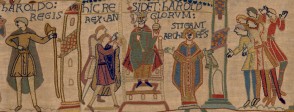The tapestry contains a lot of detail, so help students get used to looking at it by starting with a close examination of one scene.
Ask them to look carefully at Scene 3. Encourage them to observe details in the top and bottom friezes, then to concentrate on the main scene. Ask them to identify clothes and objects and to guess what is happening. Ask them to do a detailed comparison William (sitting) and Harold (standing). The differences in their physical appearance are a useful guide to looking at the tapestry: like William, Normans are shown with very short hair and clean-shaven faces. The Anglo-Saxons, like Harold, have longer hair and moustaches. Make sure they notice the Latin writing and discuss what it might say and why they think the makers included this writing.
Then move on to building up the story of the rivalry between Harold and William and the issues of interpretation.
Use the images in For the classroom to discuss the events that led up to the Norman invasion. Show students scenes 1, 2, and 3. Do students think they show Harold and William as friends or rivals? Show them scenes 4 and 5 and discuss the events depicted. What do they think Harold and Edward said to each other? Show students scene 6. How do students think William felt when he heard Harold was king? What does he do straight away?
Choose scenes from the tapestry for students to act out, first with frozen pictures, then adding movement and dialogue. Students could make costume; and could film each other’s scenes. Compare the dialogues students devise for the same scenes and their reasons for interpreting them this way.
The tapestry provides an excellent opportunity to discuss the nature of evidence in history.
Explain to the students about who the tapestry was made for and as much as we can tell about how it came to be made. Explain that some historians think that William wanted the tapestry to show Harold as a friend who promised William could be king and then betrayed him, in order to justify William’s invasion of England. How likely do the students this interpretation is and why? Show students the BBC Class Clip in For the classroom and ask them to list reasons why the tapestry is a useful source, and why it might be unreliable. Discuss how the absence of evidence from the Anglo-Saxon side affects the way we can understand these events.
Using the images and the Britain’s Bayeux Tapestry website in For the classroom , ask students to list all the things the tapestry seems to tell us about William the Conqueror. Then discuss which things require little interpretation and which require a lot.
Students could follow this discussion up by conducting their own research about Edward the confessor, Harold and William. The BBC primary history links in For the classroom are a good staring point. Who do your students think should have been king of England after Edward: Harold or William? Ask students to present their opinions and evidence to each other.
England was contested not just by the Anglo-Saxons and the Normans, but also by the Vikings in the north. Split the class into three, assigning one third the Normans, one third the Anglo-Saxons and one third the Vikings. Ask students to use the resources in For the classroom and others that you can find to research the interests, conduct and experience of each group. Combine their findings on a class timeline, perhaps using different colours to represent Norman, Anglo-Saxon and Viking. Students could also share their findings by making a series of news reports in role as Normans, Vikings or Saxons.
Look at other aspects of the Anglo-Saxon and Norman worlds for which the tapestry provides evidence. Give groups of students print-outs of the different scenes in For the classroom . What can they find out about life in the 11th century from the tapestry, for example buildings, clothes, jobs, animals, weapons, religion?
Discuss textiles with the class. Begin by asking students to look carefully at images of the Bayeux tapestry; and at other examples of textiles in A bigger picture. Discuss how the textiles were made and used. Discuss examples of textiles that students have at home. Do they have textiles that they wear, furnish their homes with or have on display? How were they made? What do they show? Are some more special than others, and why? Why do students think the Bayeux tapestry was made to hang on the wall, not for example, to be worn or used every day?
The Bayeux tapestry, and several of the examples of textiles in A bigger picture, use pictures as well as (or instead of) text to tell the events of a battle. Discuss with students why the makers chose to do this. What can we learn about the people and their actions from the pictures? Students could design their own textile piece that relies on images to tell a complicated or dramatic story.


